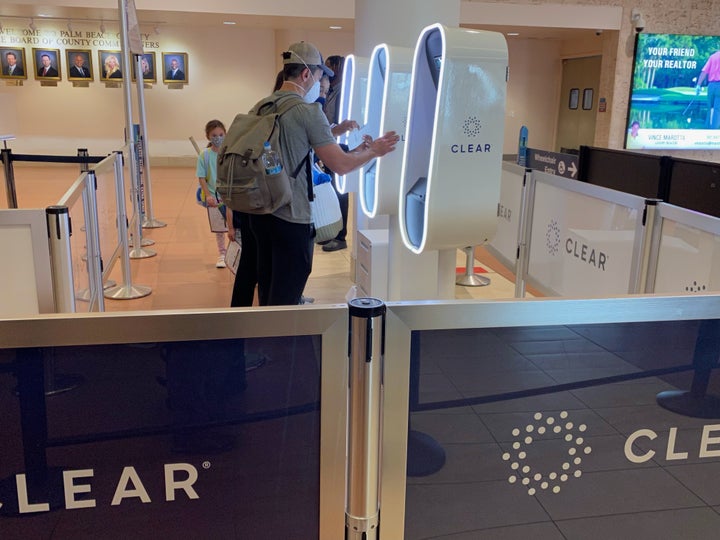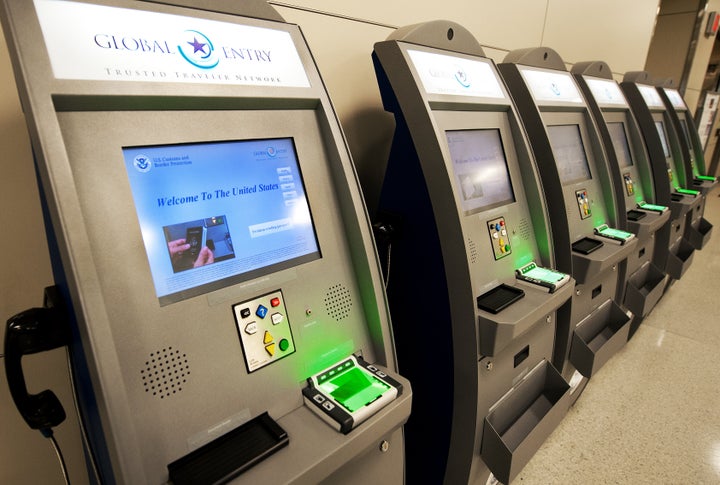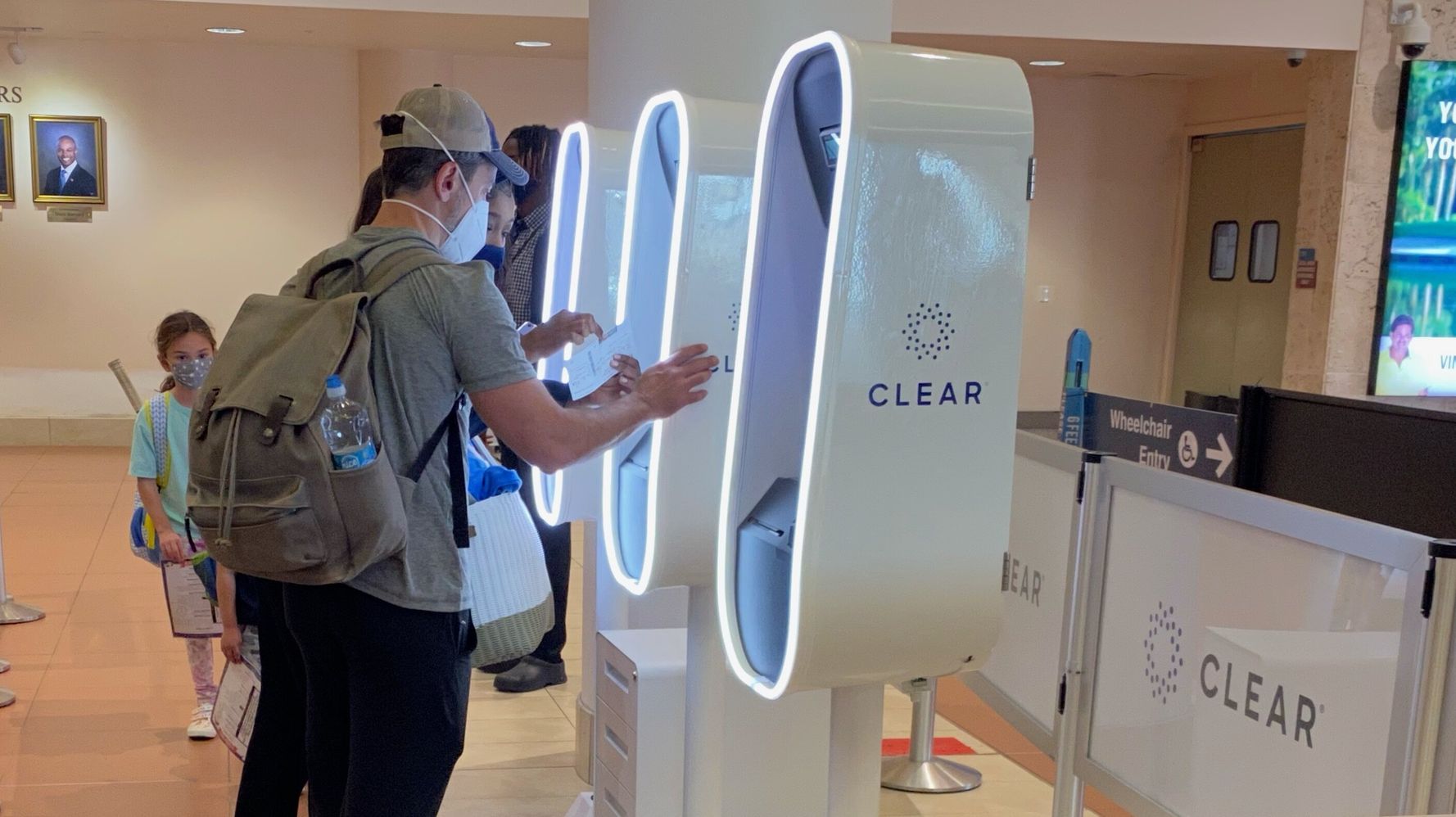Being on vacation is fun. Waiting in long lines at the airport is not.
Over the past month, the Transportation Security Administration has screened more than 2 million passengers almost every day, suggesting that pandemic-induced “revenge travel” predictions have come to pass. Travelers should be prepared for busy airports and longer wait times than we’ve seen over the past two years.
If you’ve had to stand in a long security or customs line at the airport, however, you may have noticed that some people get to shorter, quicker lines with programs like TSA PreCheck, CLEAR and Global Entry.
But what’s the difference between these three options? Read on for a breakdown and some advice for determining which is best for you, if any.
What is TSA PreCheck?
The Transportation Security Administration runs an expedited security program called TSA PreCheck for travelers departing U.S. airports.
TSA PreCheck membership gives access to a different (and usually shorter) security line at the airport with a less invasive screening process. For instance, you don’t have to remove your shoes, belt or light jacket, and you can leave your laptop and approved liquids inside your bag.
TSA PreCheck members also tend to walk through traditional metal detectors rather than full-body scanners. More than 200 U.S. airports and 80 airlines participate in the program, so you can only access these benefits if you’re flying out of the U.S. with an approved carrier (though the odds are good, given those high participation numbers).
In most cases, your TSA PreCheck screening will involve a separate line, but if a designated security lane isn’t available at that airport, you’ll have to wait in a standard line. You can check the TSA website in advance to find out if this will be the case. But even if you have to go through a standard line, your boarding pass will note that you are a TSA PreCheck member, and “you may be able to keep 3-1-1 liquids and laptops in your bag, and shoes and light jackets on,” the website notes.
John Moore via Getty Images
In March 2020, TSA PreCheck reached a milestone of 10 million members. To apply for the program, you must fill out an online application and schedule an appointment at one of more than 380 enrollment centers across the country. The appointment should last about 10 minutes and involve fingerprinting and a background check. Look up the required documents you need to bring beforehand.
To be eligible for TSA PreCheck, you must be a U.S. citizen, U.S. national or lawful permanent resident and cannot have been convicted of certain crimes. There is no age requirement to apply, but children who are 12 and under can use the PreCheck lane when traveling with a parent or guardian who is a member of the program.
The application fee is $85 and will cover your membership for five years, after which you’ll pay $70 to renew online. The agency usually notifies applicants if they’ve been approved or denied within a few weeks, though it can be as soon as a few days after the appointment.
Once you’re approved, you’ll receive a Known Traveler Number to input whenever you book a flight out of U.S. airports with participating airlines. That way, your boarding pass will note that you are a TSA PreCheck member with access to the less invasive security process. However, you can still be randomly selected for additional screening by TSA staff.
What is CLEAR?
While TSA PreCheck is a government program, CLEAR is a privately-run service ― though it is certified by the Department of Homeland Security. The company helps expedite the airport security process by streamlining the identification procedure, rather than the bag and body screening portion.
CLEAR uses biometric data ― specifically fingerprints and irises ― to identify travelers. So if you’re a CLEAR member, you don’t have to wait in a long line to show your ID to a TSA officer. Instead, you go to a separate area with special kiosks that scan either your fingers or eyes. They’ll also scan your boarding pass.
Once the machine confirms who you are (it usually takes a matter of seconds), a CLEAR representative escorts you to the front of the security line and alerts the TSA officer that your identity has been verified. Then, you proceed to the bag and body screening machines.

CLEAR doesn’t include the benefits of TSA PreCheck, so it doesn’t allow you to keep your shoes and belt on, and leave your laptop in your bag. However, if you’re a member of both CLEAR and PreCheck, the CLEAR agent can bring you to the PreCheck lane for your usual shoes-on screening. Several airports now even have two separate CLEAR checkpoints: One for members with TSA PreCheck and one for members without.
CLEAR is currently available at more than 50 U.S. airports. Many stadiums and other venues also offer CLEAR screening for concerts and sporting events, so members can skip long lines there, too.
To sign up for CLEAR, you must be a U.S. citizen or legal permanent resident 18 years of age or older, and have a valid government-issued photo ID. Children under 18 can use the CLEAR lane for free if they’re traveling with a CLEAR member.
You can complete the entire enrollment process at a CLEAR kiosk at the airport or start by registering online and then finish in person at the airport. No appointment is needed, and it shouldn’t take more than five minutes.
At the kiosk, you’ll have to answer a few questions to verify your identity, present a valid ID, share your biometric data (fingerprints from both hands and an iris scan), take a photo of your face and pay for a membership.
The regular rate is $189 per year, though there are often promotional discounts for new members. Once you’ve joined, you can also add up to three family members for $50 per person annually.
What is Global Entry?
Global Entry is another way to access expedited security screenings while traveling, specifically during international travel. Members get to go through a more automated Customs and Border Protection (CBP) process when they arrive in the U.S. after traveling abroad.
With a Global Entry membership, you can proceed to special Global Entry kiosks upon landing in the U.S. There, you scan your passport or U.S. permanent resident card, and scan your fingerprints for verification. Some airports now even have facial recognition technology to replace the passport and fingerprint steps.
Once you complete a customs declaration, the machine will print out a transaction receipt that you must give to a CPB officer before heading to the baggage claim and exit areas. And thus avoiding waiting in the standard processing lines or filling out the post-arrival paperwork required of other travelers.
Global Entry kiosks are available at 65 airports across the U.S. and a number of select international locations including Toronto, Abu Dhabi and Dublin.
Like TSA PreCheck, Global Entry is a government-run program. Both are part of the DHS Trusted Traveler Programs, and once you sign up for Global Entry, you’re automatically enrolled in TSA PreCheck as well.

PAUL J. RICHARDS via Getty Images
To be eligible for membership, you have to be a U.S. citizen, U.S. lawful permanent resident or a citizen of one of CBP’s approved countries, which include Argentina, Germany and Singapore, among others. There is no age requirement, but you can be denied enrollment for a number of reasons, such as past criminal convictions, outstanding warrants or otherwise being unable to prove a “low-risk status.”
If you want to apply for Global Entry, you must create a Trusted Traveler Programs account, complete the online application and submit a nonrefundable $100 fee, which will cover your membership for five years once approved. If CBP conditionally approves your application upon review, then you can schedule an interview at a Global Entry Enrollment Center.
Not every state has an enrollment center, but many are located at major airports. So if you don’t want to make a separate journey, you can opt for the “enrollment upon arrival” service, through which you do your interview as part of the immigration process the next time you arrive at a participating airport from an international trip.
Wherever you schedule your appointment, make sure you bring the required documents and give yourself plenty of time for a background check, interview, fingerprinting and photo. The processing time can range from a couple of weeks to several months, and if you’re approved, you’ll receive a Global Entry card in the mail.
As with TSA PreCheck, Global Entry members will also receive a Known Traveler Number they can input when booking a flight for access to the expedited line. They can still get selected for further screening, however.
Should I enroll for any of these?
Frequent fliers are quick to extol the benefits of programs like TSA PreCheck, CLEAR and Global Entry.
If you have a bad habit of arriving late to the airport, CLEAR and TSA PreCheck can both help you avoid missing flights. These expedited processes also give travelers more time to grab a bite or enjoy an airport lounge before takeoff.
Although CLEAR and TSA PreCheck lines tend to be shorter than the regular security line, there’s no guarantee you won’t have to wait at all, however. For instance, I recently flew out of the Atlanta airport on a busy Sunday morning and had to wait in line for almost 15 minutes to reach a CLEAR screening kiosk ― quite a contrast to my usual line-free experience at other airports.
For those who travel internationally, Global Entry can save you the headache of having to wait in an often long and slow line after spending many uncomfortable hours on an international flight. It’s especially useful if you have a tight connection before your next flight after landing in the U.S., as you’ll have to recheck your bags and go through the TSA security screening once you clear customs.
If you don’t have a passport, TSA PreCheck is still a great option for ease of travel on the front end of your trip. But if you think you’ll end up getting a passport and taking even one international vacation over the course of the next five years, it’s probably worth it to pay that extra $15 to get Global Entry which gives you TSA PreCheck, too.
The Global Entry application process, however, is more rigorous than TSA PreCheck’s, so you may consider sticking to PreCheck if you have reason to believe you might not get approved for Global Entry.
But perhaps the biggest factor to consider is credit card benefits. Many cards offer statement credits to reimburse you for TSA PreCheck or Global Entry fees ― or allow you to use rewards points to pay the fee. Some cards even offer full reimbursement for a CLEAR membership.
Bottom line: If you travel and have one of these cards, consider taking advantage of the opportunity to spend less time in the security line at little to no cost. Otherwise, examine your lifestyle and budget to figure out what makes the most sense.


